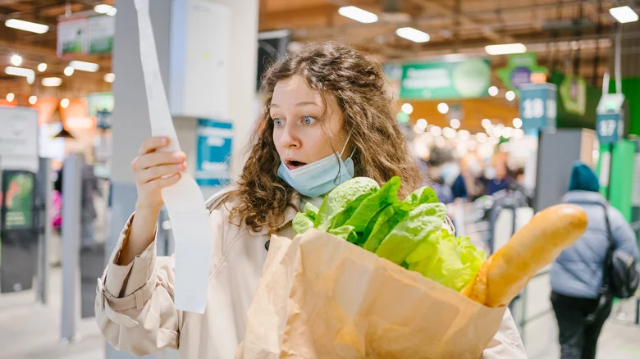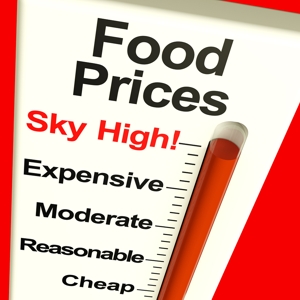I’ve been expecting someone in authority to admit the possibility for months. Now, none other than the mighty Bank Of England is warning that food prices may never drop again, even after the general post-COVID inflation surge recedes…

You think the cost of food is crazy here in North America? Brits just got the word that their food inflation rate stood at 17.3 percent for the period June 2022 to the same month this year. At the same time, the general inflation rate for the overall cost of living was down to 7.9 percent.
What’s worse, the chief economist of The Bank Of England says prices they may never go down again. Huw Pill told a recent public Q&A, he isn’t sure how much food prices may moderate after the hubbub over the war in Ukraine and shortages connected to climate change subside.
“Unfortunately the days of seeing food prices fall, that does seem to be something that we may not be seeing for a little while yet, if in the future at all,” Pill admitted.
Here at home
Our food price inflation rate is barely half that of Britain’s – 9.1 percent year over year in June. But it’s troubling enough that increasing numbers of folks are unable to put decent food on the table without the help of food banks. Alas, the food banks are having greater difficulty meeting the demand of the growing number of families in need.
It’s just my intuition, and experience at the grocery store over the past couple of years. But I think Pill’s warning could apply pretty much everywhere in the developed world.
The real causes?
A CTV News backgrounder published this week lists the main causes of food price inflation in Canada. Finally a clear, concise explanation of the issue.
And the article reveals some root causes that we may not have been aware of before.
The Loony is limp
The Loony has lost ground against the U.S. dollar over the past few years. It was at a relatively healthy high of (US)$0.83 back in 2021. But today, it’s hovering down around (US)$0.75. That means it costs 8 percent more to import U.S. food products than it did at the height of the COVID crisis. And we import a huge amount of food from the U.S. during the months when we can’t grow it ourselves.
Extreme weather hammering supplies
There’s no question that extreme weather due to climate change has become a major contributor to food shortages around the world. Here in Canada, severe drought has caused production of wheat, canola, barley and other bean and legume staples to dive by double digits. Exports are off, apparently. But we’re still meeting our own domestic needs.
War and instability
The ongoing war in Ukraine has caused systemic global shortages of wheat, fertilizer and natural gas. As recently as a few weeks ago, Russia cancelled the deal under which Ukraine was able to continue shipping grain exports abroad. That’s triggered fears of starvation in some African countries. Recent record floods in China have destroyed or imperiled a major portion of that country’s annual grain crop.
Labour shortages
Legions of folks lost or left their jobs in the food chain when it basically shut down during the COVID crisis. And they haven’t come back, yet. As a result, farmers and food processors are investing more cash in mechanization, killing many of those jobs permanently. Compounding that trend is the shortage of agriculture industry machinery caused by the COVID pandemic. But the experts day that issue is abating, though slowly.
And let’s not forget that trucking companies are still making heroic efforts to hire new drivers. Many left the profession when they were grounded during COVID.
Greedflation
Reps of Canada’s major grocery retail chains have met with different government committees about food prices. They’ve steadfastly denied that they’ve used the turmoil and confusion among consumers during and in the wake of COVID to increase food prices excessively.
CTV points out that, “Loblaw, Sobeys, Metro, Walmart and Costco control an estimated 80 per cent of the grocery market share, according to a 2021 study from the federal government.” And the potential for price gouging is huge.
“In the early days of the pandemic, there was some jockeying for price increases, mostly because there were big supply disruptions happening, but we haven’t seen an enormous amount of it,” said Will Huggins, professor of business economics at McMaster University. “They’ve certainly been able to prevent their profits from coming down, but I haven’t seen a lot of ‘exploitative’ […] numbers.”
As a result…
Canada’s Food Price Report 2023 compiled by the Agri-Food Analytics Lab at Dalhousie University predicts food prices for the year 2023 will still hover around 7 percent. That’s only a small decrease from last year’s 9.1 percent. But it’s something.
The report predicts that a Canadian family of 4 will spend over $1,000 more this year than last for the same level of foods. The largest increases will be in veggies, dairy and meat. Too bad. We need the price of fresh veggies to drop big-time if those hit hardest by soaring prices can afford fresh produce – essential for good health – are to benefit at all.
~ Maggie J.

